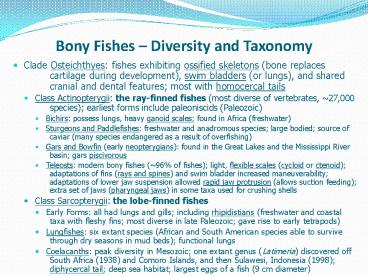Bony Fishes - PowerPoint PPT Presentation
1 / 25
Title: Bony Fishes
1
Bony Fishes Diversity and Taxonomy
- Clade Osteichthyes fishes exhibiting ossified
skeletons (bone replaces cartilage during
development), swim bladders (or lungs), and
shared cranial and dental features most with
homocercal tails - Class Actinopterygii the ray-finned fishes (most
diverse of vertebrates, 27,000 species)
earliest forms include paleoniscids (Paleozoic) - Bichirs possess lungs, heavy ganoid scales
found in Africa (freshwater) - Sturgeons and Paddlefishes freshwater and
anadromous species large bodied source of
caviar (many species endangered as a result of
overfishing) - Gars and Bowfin (early neopterygians) found in
the Great Lakes and the Mississippi River basin
gars piscivorous - Teleosts modern bony fishes (96 of fishes)
light, flexible scales (cycloid or ctenoid)
adaptations of fins (rays and spines) and swim
bladder increased maneuverability adaptations
of lower jaw suspension allowed rapid jaw
protrusion (allows suction feeding) extra set
of jaws (pharyngeal jaws) in some taxa used for
crushing shells - Class Sarcopterygii the lobe-finned fishes
- Early Forms all had lungs and gills including
rhipidistians (freshwater and coastal taxa with
fleshy fins most diverse in late Paleozoic gave
rise to early tetrapods) - Lungfishes six extant species (African and South
American species able to survive through dry
seasons in mud beds) functional lungs - Coelacanths peak diversity in Mesozoic one
extant genus (Latimeria) discovered off South
Africa (1938) and Comoro Islands, and then
Sulawesi, Indonesia (1998) diphycercal tail
deep sea habitat largest eggs of a fish (9 cm
diameter)
2
Fig. 24.1
3
Fig. 24.2
4
Fig. 24.18 and 24.19
5
Fig. 24.20
6
Fig. 24.22 and Fig. 24.23
7
Bony Fishes Form and Function
- Calcified bones including operculum (covers
gills), otoliths (ear bones that control
balance fish can get sea sick!), and fin rays
(allow maneuverability) - Teleosts with fin spines (anti-predation) many
with modifications of fins (esca of anglerfishes,
suckers, venomous spines, membranous fins of
flying fish) - Swim bladder gas-filled sac for buoyancy
control some fill via bloodstream (but only
slowly limited depth ranges), others adjust via
mouth and must live near surface (ex.
anchovies) some lack or is vestigial (tunas,
flatfishes) good target for echolocation
stores gases and can function as a lung sound
production (ex. croakers) Weberian ossciles
increase hearing ability - Multiple gills gill rakers trap prey gas
exchange at gill filaments (thin and full of
blood capillaries) gills accomplish excretion
along with kidneys - Flattened, flexible scales (cycloid or ctenoid)
- Locomotion anguilliform (body undulation, ex.
eels) carangiform and thunniform (trunk
musculature, ex. jacks, tunas) fin-movements
(ex. boxfish) - Body forms Fusiform (torpedo shaped tunas,
etc.) Laterally compressed (flat- fishes,
butterflyfishes, etc.) Snake-like (eels)
Globular (benthic groups) Tubular (ex.
trunkfish) - Reproduction sexual dimorphism, sex reversal,
and hermaphrodites common (ex wrasses,
groupers) some monogamous (butterflyfishes)
most with pelagic, planktonic larval stages
some brood benthic eggs and larvae (ex.
damselfishes) some with live birth (ex.
surfperches, seahorses males with pouch)
8
Fig. 29.8
9
Fig. 24.15
10
Fig. 24.27 and Fig. 24.28
11
Fig. 24.29
12
Fig. 31.20
13
Fig. 24.30
14
Fig. 24.16
15
Fig. 24.17
16
Fig. 24.24
17
Fig. 24.25
18
Fig. 24.35
19
Bony Fishes Feeding and Evolutionary Ecology
- Feeding modes filter feeders (ex. anchovies),
grazers (ex. surgeon- fishes), suction-feeding
planktivores (ex. many damselfishes), piscivores
(ex. groupers, tunas), crushers (ex. most
wrasses) most parrotfishes ingest coral and
digest zooxanthellae goat- fishes detect prey in
sediment with barbels most butterflyfishes
ingest coral polyps winnowing (ex. surfperches)
- Evolutionary Ecology
- Tunas and billfishes very fast, powerful (cross
entire oceans) red muscle for endurance (high
in oxygen and myoglobin) counter-current heat
exchange, rete-mirabile allow endothermy
(warm-blooded 2-10 C above ambient) high
predation rates and high metabolism bills for
predation (marlin dangerous!) - Deep-sea fishes adapted for life with little
food lack muscle counter- illumination
photophores on ventral surface to match
downwelling light - Coloration and Mimicry color patterns involve
countershading, cryptic coloration, warning
coloration, species recognition (poster
coloration), disruptive coloration, mimicry
(incl. aggressive mimicry)
20
Fig. 24.26
21
Bony Fishes Schooling, Migrations, and Fisheries
- Schooling behavior grouping with biosocial
attraction (vs. simple aggregation) - Coordination with nearest neighbors largely
mediated via lateral-line sense (experiments
with blinds, glues, nerve oblation, etc.) - Reduces predation via confusion effect and
reduction of predator/prey encounters - Other functions? Note salmon homing theory (incr.
success?) - Migrations
- American and European eels spawn in Sargasso Sea
(catadromous) - Salmon (anadromous) adults in ocean migrate
from river mouth to natal streams via olfaction
(imprinting) from ocean to river mouth via
sun- compass, magnetic cues? - Diurnal migrations ex. blacksmith (note
ecological importance) - Fisheries and Aquaculture
- Fish an important source of protein human
population now 7 billion over- fishing a result
of increased fishing technology size-limits and
quotas less effective than reserves (allow fish
a chance for reproduction) people eating fish
from lower trophic levels under-utilized
species (ex. deep-sea forms) - Aquaculture successful farms include tilapia,
salmon, shrimp, and lobster later eat fish meal
(contribute to overfishing) coastal wetlands
used/spoiled
22
Fig. 33.22
23
Fig. 24.33
24
? Fig. 24.37
Fig. 24.34
25
Fig. 24.38































